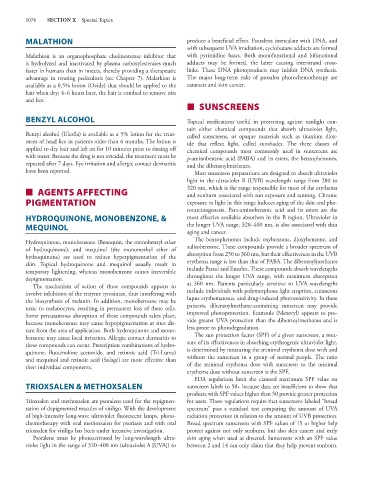Page 1090 - Basic _ Clinical Pharmacology ( PDFDrive )
P. 1090
1076 SECTION X Special Topics
MALATHION produce a beneficial effect. Psoralens intercalate with DNA, and
with subsequent UVA irradiation, cyclobutane adducts are formed
Malathion is an organophosphate cholinesterase inhibitor that with pyrimidine bases. Both monofunctional and bifunctional
is hydrolyzed and inactivated by plasma carboxylesterases much adducts may be formed, the latter causing interstrand cross-
faster in humans than in insects, thereby providing a therapeutic links. These DNA photoproducts may inhibit DNA synthesis.
advantage in treating pediculosis (see Chapter 7). Malathion is The major long-term risks of psoralen photochemotherapy are
available as a 0.5% lotion (Ovide) that should be applied to the cataracts and skin cancer.
hair when dry; 4–6 hours later, the hair is combed to remove nits
and lice.
■ SUNSCREENS
BENZYL ALCOHOL Topical medications useful in protecting against sunlight con-
tain either chemical compounds that absorb ultraviolet light,
Benzyl alcohol (Ulesfia) is available as a 5% lotion for the treat- called sunscreens, or opaque materials such as titanium diox-
ment of head lice in patients older than 6 months. The lotion is ide that reflect light, called sunshades. The three classes of
applied to dry hair and left on for 10 minutes prior to rinsing off chemical compounds most commonly used in sunscreens are
with water. Because the drug is not ovicidal, the treatment must be p-aminobenzoic acid (PABA) and its esters, the benzophenones,
repeated after 7 days. Eye irritation and allergic contact dermatitis and the dibenzoylmethanes.
have been reported. Most sunscreen preparations are designed to absorb ultraviolet
light in the ultraviolet B (UVB) wavelength range from 280 to
■ AGENTS AFFECTING 320 nm, which is the range responsible for most of the erythema
and sunburn associated with sun exposure and tanning. Chronic
PIGMENTATION exposure to light in this range induces aging of the skin and pho-
tocarcinogenesis. Para-aminobenzoic acid and its esters are the
HYDROQUINONE, MONOBENZONE, & most effective available absorbers in the B region. Ultraviolet in
MEQUINOL the longer UVA range, 320–400 nm, is also associated with skin
aging and cancer.
The benzophenones include oxybenzone, dioxybenzone, and
Hydroquinone, monobenzone (Benoquin, the monobenzyl ether
of hydroquinone), and mequinol (the monomethyl ether of sulisobenzone. These compounds provide a broader spectrum of
hydroquinone) are used to reduce hyperpigmentation of the absorption from 250 to 360 nm, but their effectiveness in the UVB
skin. Topical hydroquinone and mequinol usually result in erythema range is less than that of PABA. The dibenzoylmethanes
temporary lightening, whereas monobenzone causes irreversible include Parsol and Eusolex. These compounds absorb wavelengths
depigmentation. throughout the longer UVA range, with maximum absorption
The mechanism of action of these compounds appears to at 360 nm. Patients particularly sensitive to UVA wavelengths
involve inhibition of the enzyme tyrosinase, thus interfering with include individuals with polymorphous light eruption, cutaneous
the biosynthesis of melanin. In addition, monobenzone may be lupus erythematosus, and drug-induced photosensitivity. In these
toxic to melanocytes, resulting in permanent loss of these cells. patients, dibenzoylmethane-containing sunscreen may provide
Some percutaneous absorption of these compounds takes place, improved photoprotection. Ecamsule (Mexoryl) appears to pro-
because monobenzone may cause hypopigmentation at sites dis- vide greater UVA protection than the dibenzoylmethanes and is
tant from the area of application. Both hydroquinone and mono- less prone to photodegradation.
benzone may cause local irritation. Allergic contact dermatitis to The sun protection factor (SPF) of a given sunscreen, a mea-
these compounds can occur. Prescription combinations of hydro- sure of its effectiveness in absorbing erythrogenic ultraviolet light,
quinone, fluocinolone acetonide, and retinoic acid (Tri-Luma) is determined by measuring the minimal erythema dose with and
and mequinol and retinoic acid (Solagé) are more effective than without the sunscreen in a group of normal people. The ratio
their individual components. of the minimal erythema dose with sunscreen to the minimal
erythema dose without sunscreen is the SPF.
FDA regulations limit the claimed maximum SPF value on
TRIOXSALEN & METHOXSALEN sunscreen labels to 50+ because data are insufficient to show that
products with SPF values higher than 50 provide greater protection
Trioxsalen and methoxsalen are psoralens used for the repigmen- for users. These regulations require that sunscreens labeled “broad
tation of depigmented macules of vitiligo. With the development spectrum” pass a standard test comparing the amount of UVA
of high-intensity long-wave ultraviolet fluorescent lamps, photo- radiation protection in relation to the amount of UVB protection.
chemotherapy with oral methoxsalen for psoriasis and with oral Broad spectrum sunscreens with SPF values of 15 or higher help
trioxsalen for vitiligo has been under intensive investigation. protect against not only sunburn, but also skin cancer and early
Psoralens must be photoactivated by long-wavelength ultra- skin aging when used as directed. Sunscreens with an SPF value
violet light in the range of 320–400 nm (ultraviolet A [UVA]) to between 2 and 14 can only claim that they help prevent sunburn.

